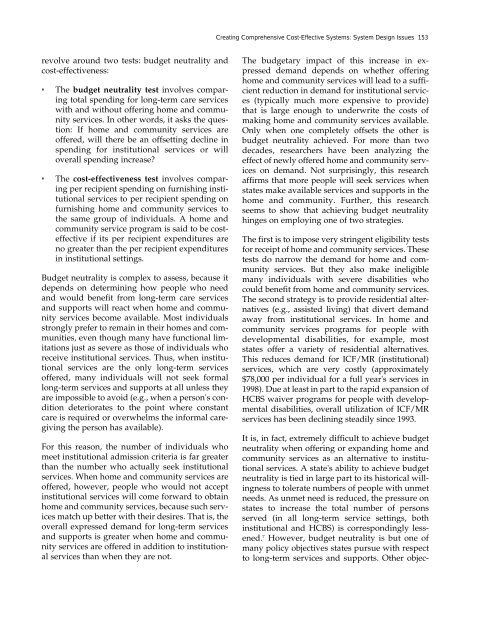Full PDF Version - ASPE - U.S. Department of Health and Human ...
Full PDF Version - ASPE - U.S. Department of Health and Human ...
Full PDF Version - ASPE - U.S. Department of Health and Human ...
- No tags were found...
You also want an ePaper? Increase the reach of your titles
YUMPU automatically turns print PDFs into web optimized ePapers that Google loves.
Creating Comprehensive Cost-Effective Systems: System Design Issues 153revolve around two tests: budget neutrality <strong>and</strong>cost-effectiveness:• The budget neutrality test involves comparingtotal spending for long-term care serviceswith <strong>and</strong> without <strong>of</strong>fering home <strong>and</strong> communityservices. In other words, it asks the question:If home <strong>and</strong> community services are<strong>of</strong>fered, will there be an <strong>of</strong>fsetting decline inspending for institutional services or willoverall spending increase?• The cost-effectiveness test involves comparingper recipient spending on furnishing institutionalservices to per recipient spending onfurnishing home <strong>and</strong> community services tothe same group <strong>of</strong> individuals. A home <strong>and</strong>community service program is said to be costeffectiveif its per recipient expenditures areno greater than the per recipient expendituresin institutional settings.Budget neutrality is complex to assess, because itdepends on determining how people who need<strong>and</strong> would benefit from long-term care services<strong>and</strong> supports will react when home <strong>and</strong> communityservices become available. Most individualsstrongly prefer to remain in their homes <strong>and</strong> communities,even though many have functional limitationsjust as severe as those <strong>of</strong> individuals whoreceive institutional services. Thus, when institutionalservices are the only long-term services<strong>of</strong>fered, many individuals will not seek formallong-term services <strong>and</strong> supports at all unless theyare impossible to avoid (e.g., when a person's conditiondeteriorates to the point where constantcare is required or overwhelms the informal caregivingthe person has available).For this reason, the number <strong>of</strong> individuals whomeet institutional admission criteria is far greaterthan the number who actually seek institutionalservices. When home <strong>and</strong> community services are<strong>of</strong>fered, however, people who would not acceptinstitutional services will come forward to obtainhome <strong>and</strong> community services, because such servicesmatch up better with their desires. That is, theoverall expressed dem<strong>and</strong> for long-term services<strong>and</strong> supports is greater when home <strong>and</strong> communityservices are <strong>of</strong>fered in addition to institutionalservices than when they are not.The budgetary impact <strong>of</strong> this increase in expresseddem<strong>and</strong> depends on whether <strong>of</strong>feringhome <strong>and</strong> community services will lead to a sufficientreduction in dem<strong>and</strong> for institutional services(typically much more expensive to provide)that is large enough to underwrite the costs <strong>of</strong>making home <strong>and</strong> community services available.Only when one completely <strong>of</strong>fsets the other isbudget neutrality achieved. For more than twodecades, researchers have been analyzing theeffect <strong>of</strong> newly <strong>of</strong>fered home <strong>and</strong> community serviceson dem<strong>and</strong>. Not surprisingly, this researchaffirms that more people will seek services whenstates make available services <strong>and</strong> supports in thehome <strong>and</strong> community. Further, this researchseems to show that achieving budget neutralityhinges on employing one <strong>of</strong> two strategies.The first is to impose very stringent eligibility testsfor receipt <strong>of</strong> home <strong>and</strong> community services. Thesetests do narrow the dem<strong>and</strong> for home <strong>and</strong> communityservices. But they also make ineligiblemany individuals with severe disabilities whocould benefit from home <strong>and</strong> community services.The second strategy is to provide residential alternatives(e.g., assisted living) that divert dem<strong>and</strong>away from institutional services. In home <strong>and</strong>community services programs for people withdevelopmental disabilities, for example, moststates <strong>of</strong>fer a variety <strong>of</strong> residential alternatives.This reduces dem<strong>and</strong> for ICF/MR (institutional)services, which are very costly (approximately$78,000 per individual for a full year's services in1998). Due at least in part to the rapid expansion <strong>of</strong>HCBS waiver programs for people with developmentaldisabilities, overall utilization <strong>of</strong> ICF/MRservices has been declining steadily since 1993.It is, in fact, extremely difficult to achieve budgetneutrality when <strong>of</strong>fering or exp<strong>and</strong>ing home <strong>and</strong>community services as an alternative to institutionalservices. A state's ability to achieve budgetneutrality is tied in large part to its historical willingnessto tolerate numbers <strong>of</strong> people with unmetneeds. As unmet need is reduced, the pressure onstates to increase the total number <strong>of</strong> personsserved (in all long-term service settings, bothinstitutional <strong>and</strong> HCBS) is correspondingly lessened.7 However, budget neutrality is but one <strong>of</strong>many policy objectives states pursue with respectto long-term services <strong>and</strong> supports. Other objec-
















